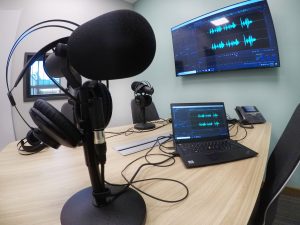Podcast Studio
The Ada Podcast Studio features a mostly sound-restricted room and a complete suite of technology for creating podcasts.
This studio is located in the new Amy Van Andel Library. Library staff are not experts with Podcasting and Podcast equipment. Library staff can orient you to the basics of the equipment. We highly encourage viewing the instructions listed below before your reservation.
NOTE: A library card is required to reserve this room.

